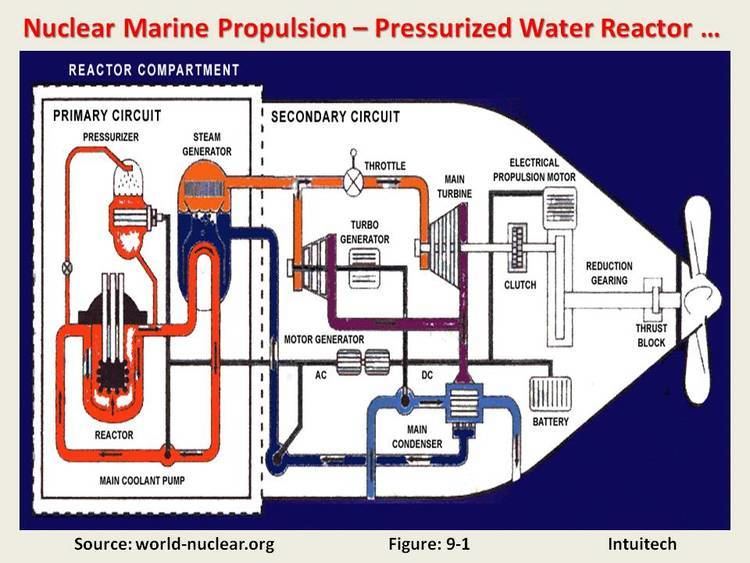 | ||
Nuclear marine propulsion
Nuclear marine propulsion is propulsion of a ship or submarine with heat provided by a nuclear power plant. The power plant heats water to produce steam and it is this steam that powers the steam turbines and turbo generators. The power is then transferred to a gearbox that reduces the ratio by around 50 to 1 and this powers the propulsor. Naval nuclear propulsion is used specifically within naval warships (see Nuclear navy). Very few experimental civil nuclear ships have been built.
Contents
- Nuclear marine propulsion
- Basic operation of naval ship or submarine
- Differences from land power plants
- Decommissioning
- Future designs
- Civil liability
- Military
- Background
- Submarines
- Aircraft carriers
- Destroyers and cruisers
- Merchant ships
- Icebreakers
- Civilian nuclear ships
- Merchant cargo ships
- Nuclear powered icebreakers
- References
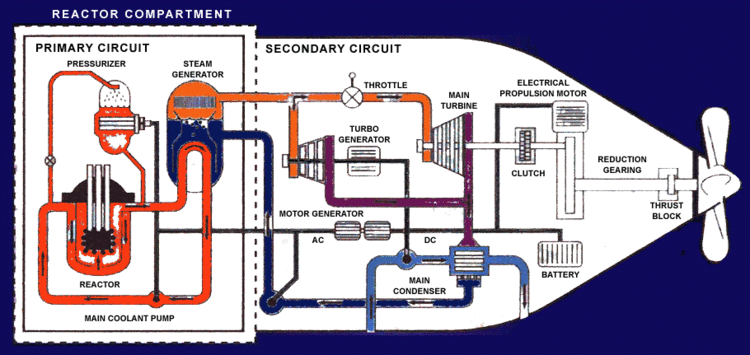
Basic operation of naval ship or submarine

The ship or submarine will be fitted with one nuclear power plant. The plant is divided into two sides, port and starboard. This division of the plant provides a safety net should one side fail to function. Water is used to transfer heat generated by the power plant to steam generators (pressure vessels whose temperature is raised to approximately 250 to 300 °C (482 to 572 °F) by the heating element of the power plant's primary circuit). Since water vaporizes at 100 °C (212 °F) at normal pressure the system is pressurized, increasing the boiling temperature of the water. To transfer the heated water there are two sets of pumps on each side.
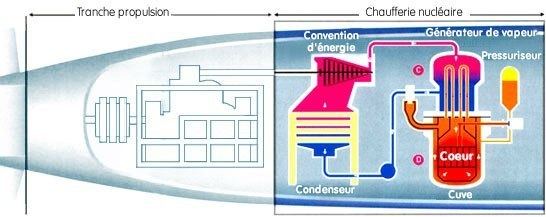
The steam is provided by water commonly referred to as feed water. This feed water is sea water pumped into the boat and desalinated. The desalinated water is then fed to the steam generators.
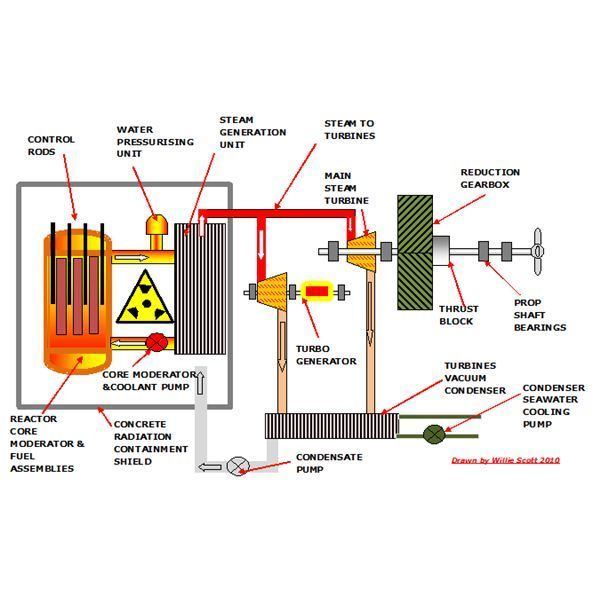
The primary circuit then heats the feed water turning it to steam. The steam passes through several driers and onto the main steam stop valve (port and starboard) as super heated dry steam.
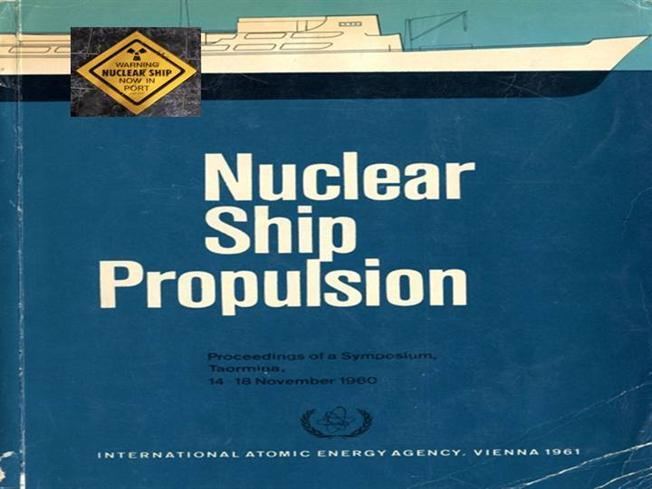
The Russian, US and British navies rely on steam turbine propulsion, while the French and Chinese ships use the turbine to generate electricity for propulsion (turbo-electric transmission). Most nuclear submarines have a single reactor, but Russian submarines and USS Triton had two. Most American aircraft carriers are powered by two reactors, but USS Enterprise had eight. The majority of marine reactors are of the pressurized water type, although the US and Soviet navies have designed warships powered with liquid metal cooled reactors.
Differences from land power plants
Marine-type reactors differ from land-based commercial electric power reactors in several respects.
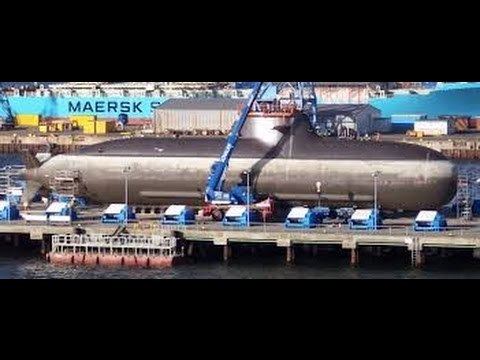
While land-based reactors in nuclear power plants produce up to around 1600 megawatts of power, a typical marine propulsion reactor produces no more than a few hundred megawatts. Space considerations dictate that a marine reactor must be physically small, so it must generate higher power per unit of space. This means its components are subject to greater stresses than those of a land-based reactor. Its mechanical systems must operate flawlessly under the adverse conditions encountered at sea, including vibration and the pitching and rolling of a ship operating in rough seas. Reactor shutdown mechanisms cannot rely on gravity to drop control rods into place as in a land-based reactor that always remains upright. Salt water corrosion is an additional problem that complicates maintenance.
The fuel in a seagoing reactor is typically more highly enriched (i.e., contains a higher concentration of U235 vs. U238) than that used in a land-based nuclear power plant. Some marine reactors run on relatively low-enriched uranium which requires more frequent refueling. Others run on highly enriched uranium, varying from 20% U235, to the over 96% U235 found in U.S. submarines, in which the resulting smaller core is quieter in operation (a big advantage to a submarine). Using more-highly enriched fuel also increases the reactor's power density and extends the usable life of the nuclear fuel load, but is more expensive and a greater risk to nuclear proliferation than less-highly enriched fuel.
A marine nuclear propulsion plant must be designed to be highly reliable and self-sufficient, requiring minimal maintenance and repairs, which might have to be undertaken many thousands of miles from its home port. One of the technical difficulties in designing fuel elements for a seagoing nuclear reactor is the creation of fuel elements which will withstand a large amount of radiation damage. Fuel elements may crack over time and gas bubbles may form. The fuel used in marine reactors is a metal-zirconium alloy rather than the ceramic UO2 (uranium oxide) often used in land-based reactors. Marine reactors are designed for long core life, enabled by the relatively high enrichment of the uranium and by incorporating a "burnable poison" in the fuel elements, which is slowly depleted as the fuel elements age and become less reactive. The gradual dissipation of the "nuclear poison" increases the reactivity of the core to compensate for the lessening reactivity of the aging fuel elements, thereby lengthening the usable life of the fuel. The life of the compact reactor pressure vessel is extended by providing an internal neutron shield, which reduces the damage to the steel from constant bombardment by neutrons.
Decommissioning
Decommissioning nuclear-powered submarines has become a major task for US and Russian navies. After defuelling, U.S. practice is to cut the reactor section from the vessel for disposal in shallow land burial as low-level waste (see the Ship-Submarine recycling program). In Russia, whole vessels, or sealed reactor sections, typically remain stored afloat, although a new facility near Sayda Bay is to provide storage in a concrete-floored facility on land for some submarines in the far north.
Future designs
Russia is well advanced with plans to build a floating nuclear power plant for their far eastern territories. The design has two 35 MWe units based on the KLT-40 reactor used in icebreakers (with refueling every four years). Some Russian naval vessels have been used to supply electricity for domestic and industrial use in remote far eastern and Siberian towns.
Lloyd's Register is investigating the possibility of civilian nuclear marine propulsion and rewriting draft rules (see text under Merchant Ships).
Civil liability
Insurance of nuclear vessels is not like the insurance of conventional ships. The consequences of an accident could span national boundaries, and the magnitude of possible damage is beyond the capacity of private insurers. A special international agreement, the Brussels Convention on the Liability of Operators of Nuclear Ships, developed in 1962, would have made signatory national governments liable for accidents caused by nuclear vessels under their flag but was never ratified owing to disagreement on the inclusion of warships under the convention. Nuclear reactors under United States jurisdiction are insured by the provisions of the Price Anderson Act.
Military
By 1990 there were more nuclear reactors powering ships (mostly military) than there were generating electric power in commercial power plants worldwide.
Background
Under the direction of U.S. Navy Captain (later Admiral) Hyman G. Rickover, the design, development and production of nuclear marine propulsion plants started in the USA in the 1940s. The first prototype naval reactor was constructed and tested at the Naval Reactor Facility at the National Reactor Testing Station in Idaho (now called the Idaho National Laboratory) in 1953.
Submarines
The first nuclear submarine, USS Nautilus (SSN-571), put to sea in 1955 (SS was a traditional designation for US submarines, while SSN denoted the first "nuclear" submarine).
The Soviet Union also developed nuclear submarines. The first types developed were the Project 627, NATO designated November class with two water-cooled reactors, the first of which, K-3 Leninskiy Komsomol, was underway under nuclear power on July 4, 1958.
Nuclear power revolutionized the submarine, finally making it a true "underwater" vessel, rather than a "submersible" craft, which could only stay underwater for limited periods. It gave the submarine the ability to operate submerged at high speeds, comparable to those of surface vessels, for unlimited periods, dependent only on the endurance of its crew. To demonstrate this USS Triton was the first vessel to execute a submerged circumnavigation of the Earth (Operation Sandblast), doing so in 1960.
Nautilus, with a pressurized water reactor (PWR), led to the parallel development of other submarines like a unique liquid metal cooled (sodium) reactor in USS Seawolf, or two reactors in Triton, and then the Skate-class submarines, powered by single reactors, and a cruiser, USS Long Beach, in 1961, powered by two reactors.
By 1962 the United States Navy had 26 operational nuclear submarines and another 30 under construction. Nuclear power had revolutionized the Navy. The United States shared its technology with the United Kingdom, while French, Soviet, Indian and Chinese development proceeded separately.
After the Skate-class vessels, US submarines were powered by a series of standardized, single-reactor designs built by Westinghouse and General Electric. Rolls-Royce plc built similar units for Royal Navy submarines, eventually developing a modified version of their own, the PWR-2 (pressurized water reactor).
The largest nuclear submarines ever built are the 26,500 tonne Russian Typhoon class. The smallest nuclear warships to date are the 2,700 tonne French Rubis-class attack submarines. The US Navy operated an unarmed nuclear submarine, the NR-1 Deep Submergence Craft, between 1969 and 2008, which was not a combat vessel but was the smallest nuclear powered submarine at 400 tons.
Aircraft carriers
United States and France have built nuclear aircraft carriers. The sole French example is Charles de Gaulle, commissioned in 2001.
The United States Navy have a much broader experience. USS Enterprise, in service 1962–2012, powered by eight reactor units, is still the only aircraft carrier to house more than two nuclear reactors, with each A2W reactor taking the place of one of the conventional boilers in earlier constructions.
Recent US vessels include the Nimitz and successor Gerald R. Ford classes.
Destroyers and cruisers
The United States Navy has examples of these vessels, utilising the D2G and C1W reactors.
Merchant ships
Nuclear-powered, civil merchant ships have not developed beyond a few experimental ships. The US-built NS Savannah, completed in 1962, was primarily a demonstration of civil nuclear power and was too small and expensive to operate economically as a merchant ship. The design was too much of a compromise, being neither an efficient freighter nor a viable passenger liner. The German-built Otto Hahn, a cargo ship and research facility, sailed some 650,000 nautical miles (1,200,000 km) on 126 voyages over 10 years without any technical problems. However, it proved too expensive to operate and was converted to diesel. The Japanese Mutsu was dogged by technical and political problems. Its reactor had significant radiation leakage and fishermen protested against the vessel's operation. All of these three ships used low-enriched uranium. Sevmorput, a Soviet and later Russian LASH carrier with icebreaking capability, has operated successfully on the Northern Sea Route since it was commissioned in 1988. As of 2012, it is the only nuclear-powered merchant ship in service.
Civilian nuclear ships suffer from the costs of specialized infrastructure. The Savannah was expensive since it required many initial costs for the first ship of its class and a nuclear civilian ship, as well as costs for a nuclear shore staff, and servicing facility. As there was only one ship, this was an expensive infrastructure for one. A larger nuclear fleet would be able to use the same infrastructure reducing successive incremental costs: each ship would be cheaper than the last.
Recently there has been renewed interest in nuclear propulsion, and some proposals have been drafted. For example, the cargo coaster is a new design for a nuclear cargo ship.
In November 2010 British Maritime Technology and Lloyd's Register embarked upon a two-year study with US-based Hyperion Power Generation (now Gen4 Energy), and the Greek ship operator Enterprises Shipping and Trading SA to investigate the practical maritime applications for small modular reactors. The research intended to produce a concept tanker-ship design, based on a 70 MWt reactor such as Hyperion's. In response to its members' interest in nuclear propulsion, Lloyd's Register has also re-written its 'rules' for nuclear ships, which concern the integration of a reactor certified by a land-based regulator with the rest of the ship. The overall rationale of the rule-making process assumes that in contrast to the current marine industry practice where the designer/builder typically demonstrates compliance with regulatory requirements, in the future the nuclear regulators will wish to ensure that it is the operator of the nuclear plant that demonstrates safety in operation, in addition to the safety through design and construction. Nuclear ships are currently the responsibility of their own countries, but none are involved in international trade. As a result of this work in 2014 two papers on commercial nuclear marine propulsion were published by Lloyd's Register and the other members of this consortium. These publications review past and recent work in the area of marine nuclear propulsion and describe a preliminary concept design study for a 155,000 dwt Suezmax tanker that is based on a conventional hull form with alternative arrangements for accommodating a 70 MWt nuclear propulsion plant delivering up to 23.5 MW shaft power at maximum continuous rating (average: 9.75 MW). The Gen4Energy power module is considered. This is a small fast-neutron reactor using lead-bismuth eutectic cooling and able to operate for ten full-power years before refueling, and in service last for a 25-year operational life of the vessel. They conclude that the concept is feasible, but further maturity of nuclear technology and the development and harmonisation of the regulatory framework would be necessary before the concept would be viable.
Icebreakers
Nuclear propulsion has proven both technically and economically feasible for nuclear-powered icebreakers in the Soviet Arctic. Nuclear-fuelled ships operate for years without refueling, and the vessels have powerful engines, well-suited to the task of icebreaking.
The Soviet icebreaker Lenin was the world's first nuclear-powered surface vessel in 1959 and remained in service for 30 years (new reactors were fitted in 1970). It led to a series of larger icebreakers, the 23,500 ton Arktika class of six vessels, launched beginning in 1975. These vessels have two reactors and are used in deep Arctic waters. NS Arktika was the first surface vessel to reach the North Pole.
For use in shallow waters such as estuaries and rivers, shallow-draft, Taymyr class icebreakers are being built in Finland and then fitted with their single-reactor, nuclear propulsion system in Russia. They are built to conform to international safety standards for nuclear vessels.
Civilian nuclear ships
The following are ships that are or were in commercial or civilian use and have nuclear marine propulsion.
Merchant cargo ships
Nuclear-powered icebreakers
All nuclear-powered icebreakers have been commissioned by the Soviet Union or Russia.
